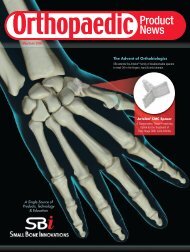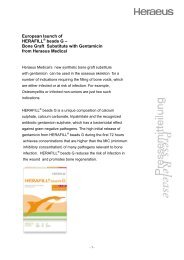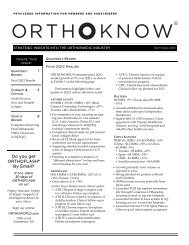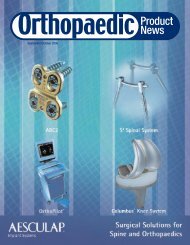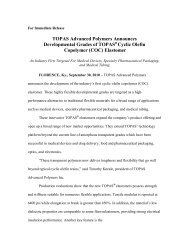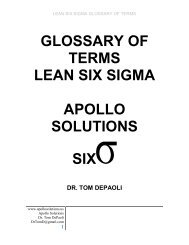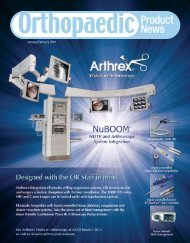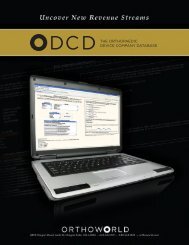Hip & Knee Surgery - Orthoworld
Hip & Knee Surgery - Orthoworld
Hip & Knee Surgery - Orthoworld
Create successful ePaper yourself
Turn your PDF publications into a flip-book with our unique Google optimized e-Paper software.
RESEARCH TO REALITYcontinued from page 56Table 2: History of NIAMS competing research project grants (RPG)Fiscal Year Total Number of Awards Total Dollars Awarded Average Cost Percentile Payline NIAMS Success Rate NIH Success Rate1998 1998 225 $46,971,000 $46,971,000$208,76020 28.10% 31.10%1999 1999 195 $51,931,000 $51,931,000$266,31320 24.40% 32.40%200020012002200320042005200620072000 238 $62,278,000 $62,278,000$261,67224 27.40% 31.50%2001 281 $77,244,000 $77,244,000$274,89024 28.60% 32.10%2002 257 $74,806,000 $74,806,000$291,07421 23.20% 31.20%2003 242 $75,109,000 $75,109,000$310,36818.5 20.40% 29.90%2004 245 $73,147,000 $73,147,000$298,55917 20.10% 24.60%2005 244 $74,842,000 $74,842,000$306,73016 20.20% 22.30%2006 247 $77,412,000 $77,412,000$313,40914.5 19.30% 20.00%2007 261 $75,954,000 $75,954,000$291,01115 20.00% 21.30%Note: Success rates indicate the percentage of reviewed RPG applications that receive funding.Source: www.niams.nih.gov/About_Us/Budget/rpg_history.aspjournals. A notable exception can be new researchers who supportthe work of the primary investigators.Frequently, the relationship amongst team leaders is symbiotic.A researcher leading one project might use a team member as a consultant,but then in turn consult for that team member’s later orconcurrent project. It’s appropriate that team members be involvedin several mutual projects. What’s important is that membershipinto the team must be mutually beneficial, and that everyone on theteam contributes to each project.As a final note of team composition, it is integral that team membershave previous grant funding. Reputation is a cornerstoneattribute, and a successful history of funding can be an essentialasset in winning grant proposals. In those cases that none of theteam members has won a grant, it might be good to strategize howthe team could recruit a new member who fills this criterion.Team dynamics, obviously, can be a dominating factor. Teammembers must be willing to contribute evenly, give up some levelsof control to team mates, and perhaps most importantly, shareresources (including funds, personnel, equipment and space). Thiscan lead to research that is important and successful, and whichmight not have been the research project the surgeon wanted toconduct in the first place!The time of the lone researcher and pet projects is over, and successfulresearchers understand that their contributions are amplifiedten to a hundredfold within the right team set-up.Multi-disciplinary and multi-institutional collaboration is notthe simplest goal to achieve, and researchers must work closelytogether and with their administrative counterparts who will overseeall official budgets, non-disclosure agreements and intellectualproperty agreements (among many other agreements!). The administrativecounterparts will also be integral in managing the grantmonies and keeping track of costs, because in most every case,grantors want detailed and exhaustive reports on how the fundswere spent and the results of the research—the “bang for yourbuck” so to speak. These reports can become the backbone of arenewal proposal to continue funding.Getting StartedIn many cases, successful clinician scientists are born, not bred,in that they attend medical schools or graduate programs withmentorship that sets them in the right place from the beginning oftraining. Starting with a less-than-pedigreed research resumé andfew resources with a goal of achieving the highest levels of fundingcan seem like a nearly-impossible task.However, with the right perspective and strategy, the task isquite possible. To start, find those in the field who are doing theresearch you are doing, and who are being paid in grant dollars forresearch in the field. Find them in journals and in professional conferences,and connect with them. Get their advice, and most importantly,find out how you can become a player on their researchteam, subcontracting some part of their existing grant programs.These connections will allow you to add valuable references andresearch partners to your future proposals, as well as get you in theloop in terms of opportunities available. As you continue to helpthese partners, you’ll soon be able to direct your own research. Foryour own proposals, one way to move forward includes traininggrants offered by a variety of government agencies and privatefoundations. These cover early career clinician scientists as well asmid-career physicians who would now like to transition intoresearch. Earning one of these degrees, along with your connections,can set you in a very competitive place.Sourceswww.niams.nih.govwww.oref.org/grantswww.grants.govChris Przybyszewski is the Director of Grants & Communications at theInMotion Orthopaedic Research Center. InMotion's mission is to acceleratescientific discoveries in orthopaedics that enhance personal mobility,leading to greater individual freedom and a more fulfilling life. Chris canbe reached at chris@inmotionmemphis.org.November/December 2009 • ORTHOPAEDIC PRODUCT NEWS 57



